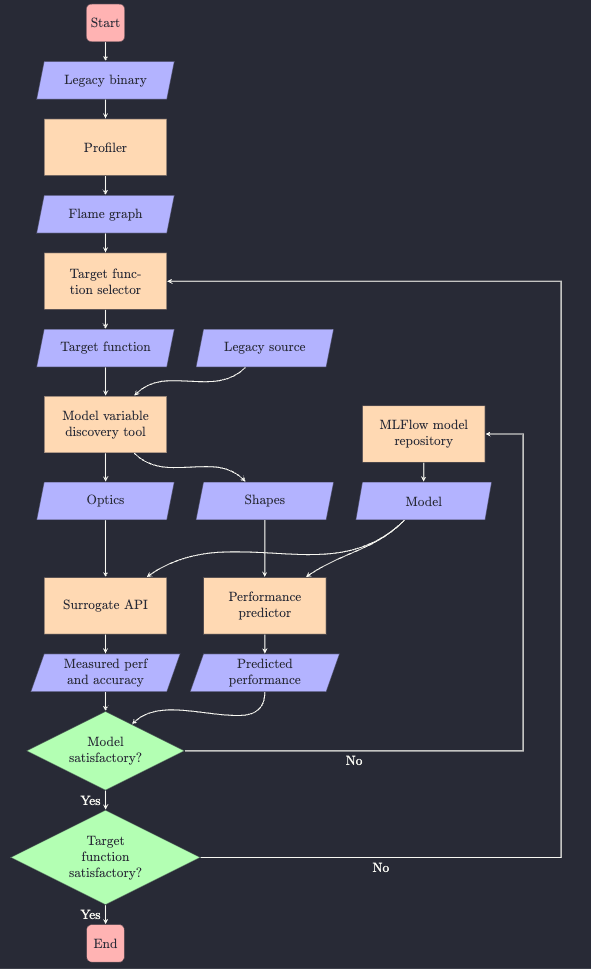Difference between revisions of "AI Surrogate Models LDRD"
| (12 intermediate revisions by 3 users not shown) | |||
| Line 9: | Line 9: | ||
* Source code lives here: https://github.com/nathanwbrei/phasm | * Source code lives here: https://github.com/nathanwbrei/phasm | ||
| + | ** [[HOWTO build and run PHASM on Geant4 examples]] | ||
| + | ** [https://docs.google.com/spreadsheets/d/19iVKLKfVFlASZSgHDrYQx6XqakzqsAp0i52GIF5nEWs/edit#gid=0 PHASM test result tracking] | ||
* [https://wiki.jlab.org/epsciwiki/index.php/SRGS_2022 SRGS 2022] | * [https://wiki.jlab.org/epsciwiki/index.php/SRGS_2022 SRGS 2022] | ||
* [https://trello.com/b/iHKfTSKB/project-planning Project planning (Trello page)] | * [https://trello.com/b/iHKfTSKB/project-planning Project planning (Trello page)] | ||
| Line 19: | Line 21: | ||
Passcode: cWidgE | Passcode: cWidgE | ||
| − | + | * [[Minutes from the 25 August 2022 meeting]] | |
| − | + | * [[Minutes from the 1 Dec 2022 meeting]] | |
== Documents == | == Documents == | ||
| Line 51: | Line 53: | ||
| Nathan Brei | | Nathan Brei | ||
| [https://indico.cern.ch/event/1106990/contributions/4991290/attachments/2535525/4363650/ACAT_PHASM_talk.pdf PDF] | | [https://indico.cern.ch/event/1106990/contributions/4991290/attachments/2535525/4363650/ACAT_PHASM_talk.pdf PDF] | ||
| + | |- | ||
| + | | 2023-05-01 | ||
| + | | CHEP 2023 | ||
| + | | Xinxin Mei | ||
| + | | [https://github.com/cissieAB/pytorch-paradnn/blob/master/docs/CHEP_GPU4ML4NP_05022023.pdf poster] | ||
|} | |} | ||
| Line 60: | Line 67: | ||
! Title | ! Title | ||
|- | |- | ||
| − | | | + | | March 2024 |
| − | | | + | | [https://www.osti.gov/ US DOE OSTI] Technical Report |
| − | | | + | | [https://doi.org/10.2172/2331226 PHASM: A Toolkit for Creating AI Surrogate Models within Legacy Codebases] |
| + | |- | ||
| + | | March 2023 | ||
| + | | ACAT 2022 proceedings (preprint) | ||
| + | | [[Media:ACAT PHASM paper.pdf|PHASM: A toolkit for creating AI surrogate models within legacy codebases]] | ||
| + | |- | ||
|} | |} | ||
| + | === Graphics === | ||
| + | |||
| + | ==== PHASM flowchart ==== | ||
| + | |||
| + | [[File:Phasm_flowchart.png]] | ||
| + | |||
| + | Rectangles denote programs or scripts, parallelograms denote data, diamonds denote decisions, and arrows denote data flow. | ||
=== Notes === | === Notes === | ||
Latest revision as of 15:37, 16 September 2024
Running Legacy Code on Heterogeneous Hardware via Surrogate Models
Project Description
PHASM ("Parallel Hardware viA Surrogate Models") is a software toolkit, currently under development, for creating AI-based surrogate models of scientific code. AI-based surrogate models are widely used for creating fast and inverse simulations. The project anticipates an additional, future use case: adapting legacy code to modern hardware. Data centers are investing in heterogeneous hardware such as GPUs and FPGAs; meanwhile, many important codebases are unable to take advantage of this hardware's superior parallelism without undergoing a costly rewrite. An alternative is to train a neural net surrogate model to mimic the computationally intensive functions in the code, and deploy the surrogate on the exotic hardware instead. PHASM addresses three specific challenges: (1) systematically discovering which functions can be effectively replaced with a surrogate, (2) automatically identifying, for a given function, the true space of inputs and outputs including those not apparent from the type signature, and (3) integrating a machine learning model into a legacy codebase cleanly and with a high level of abstraction. In the first year of development, a proof of concept has been developed for each challenge. A surrogate API makes it easy to bring PyTorch models into the C++ ecosystem and uses profunctor optics to establish a two-way data binding between C++ datatypes and tensors. A model variable discovery tool performs a dynamic binary analysis using Intel PIN in order to identify a target function's model variable space, including types, shapes, and ranges, and generate the optics code necessary to bind the model to the function. Future work may include exploring the limits of surrogate models for functions of increasing size and complexity, and adaptively generating synthetic training data based on uncertainty estimates.
General Resources
- Source code lives here: https://github.com/nathanwbrei/phasm
- SRGS 2022
- Project planning (Trello page)
Meetings
Thursday 2-3pm, bi-weekly. Teams.
Meeting ID: 281 724 015 543
Passcode: cWidgE
Documents
Proposals
Presentations
| Date | Event | Presenter | Slides |
|---|---|---|---|
| 2022-06-27 | SRGS 2022 | Nathan Brei, David Lawrence | |
| 2022-08-24 | W&M collab | Nathan Brei | |
| 2022-10-27 | ACAT 2022 | Nathan Brei | |
| 2023-05-01 | CHEP 2023 | Xinxin Mei | poster |
Publications
| Date | Journal | Title |
|---|---|---|
| March 2024 | US DOE OSTI Technical Report | PHASM: A Toolkit for Creating AI Surrogate Models within Legacy Codebases |
| March 2023 | ACAT 2022 proceedings (preprint) | PHASM: A toolkit for creating AI surrogate models within legacy codebases |
Graphics
PHASM flowchart
Rectangles denote programs or scripts, parallelograms denote data, diamonds denote decisions, and arrows denote data flow.
Notes
- The NVIDIA GPU profiling tool for the GPU Roofline analysis, Xinxin Mei
- Utilizing Advisor and Likwid for CPU Roofline analysis, Xinxin Mei
- The Roofline analysis of a libtorch C++ GPU PINN-heat equation implementation, Xinxin Mei
